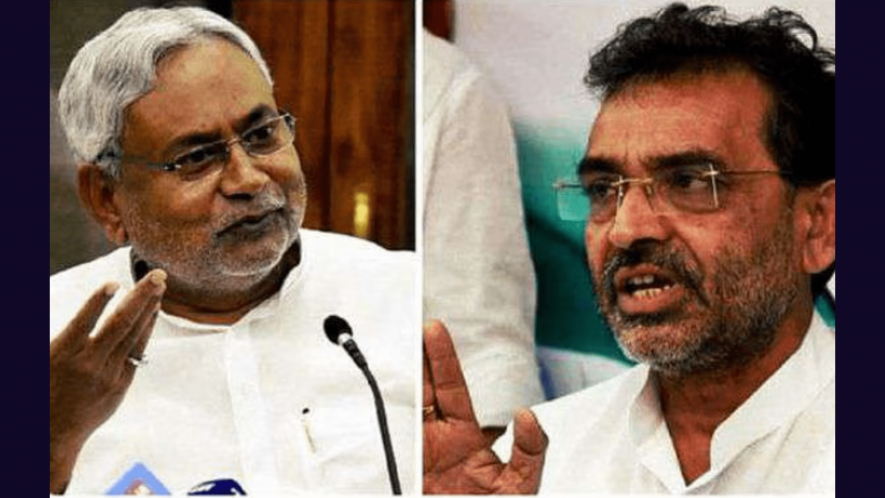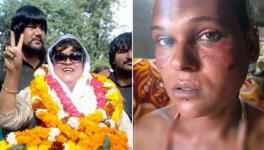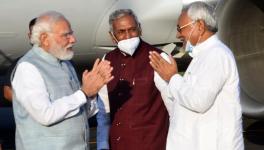Why Bihar CM Groomed Upendra Kushwaha Yet Picked Tejashwi Yadav

Nitish Kumar and Upendra Kushwaha. Image Courtesy: National Herald
Upset over Bihar Chief Minister Nitish Kumar’s choosing his deputy and Rashtriya Janata Dal (RJD) leader Tejashwi Prasad Yadav as his successor, the rebellious Janata Dal (United) parliamentary board chairman Upendra Kushwaha left his party again to float the Rashtriya Lok Janata Dal. He accused Nitish of ditching his old friends and switching sides frequently. Kushwaha may have a point. The Samata Party, the earlier version of the JD(U), had essentially arrived on October 19, 1994 as a Luv-Kush (Kurmi-Koeri) combination against what they called total Yadav domination over the Janata Dal, then led by Lalu Prasad.
But it is also for Kushwaha to explain why Nitish took a U-turn and is now so inclined towards Tejashwi, Lalu’s youngest son. After all, no Koeri leader had Nitish reposed so much faith as in Kushwaha. Nitish made Kushwaha, elected in 2000 for the first time from the Jandaha Assembly segment of Hajipur, deputy leader of the Samata Party. Nitish was then in the Atal Bihari Vajpayee Cabinet.
Actually, Nitish was chief minister of Bihar for the first time for a week between March 3 and 10, 2000 but had to resign after he failed to prove his majority on the floor of the House. He returned to Delhi and was later re-inducted into the Vajpayee ministry. Kushwaha was made deputy leader of his party in the Bihar Assembly, and after the May 2004 Lok Sabha election, he became Leader of the Opposition in the Bihar Assembly. This was because the Leader of the Opposition at the time, Sushil Kumar Modi of the Bharatiya Janata Party, got elected to the Lok Sabha from the Bhagalpur seat.
After that parliamentary election, the number of MLAs of the Samata Party increased by one compared to its alliance partner, BJP. Nitish immediately helped young Kushwaha become the Leader of Opposition. Several BJP leaders were miffed by the alacrity Nitish showed in elevating Kushwaha. But since the saffron party was voted out of power at the Centre, and the National Democratic Alliance’s performance in Bihar, too, was dismal, it did not protest. The BJP also wanted to contest the February 2005 Assembly poll with Nitish as the chief ministerial face of the National Democratic Alliance or NDA.
The way Nitish groomed and promoted Kushwaha was not liked by many within his own Samata Party, which subsequently became the Janata Dal (United).
Kushwaha Himself To Blame
But Kushwaha lost the October-November 2005 Assembly election held in Bihar from his own Assembly seat. As the February 2005 poll threw up a hung Assembly, a second election was held within eight months. It gave a clear-cut victory to the NDA. On November 24, 2005, Nitish became chief minister again, ending the 15-year rule of Lalu Prasad and his wife, Rabri Devi.
However, ambitious Kushwaha was unlucky as he lost the election when the wind blew in favour of the NDA. Still, he had expected something from Nitish. But as he had lost his bargaining position, Nitish overlooked him during Cabinet formation.
Kushwaha quit the party and, in 2006, joined the Nationalist Congress Party or NCP and became its Bihar unit president. He started targeting his former mentor, who later got his official bungalow in Patna forcibly vacated.
However, on October 31, 2009, at a function to commemorate the birth anniversary of Sardar Vallabhbhai Patel, Nitish invited Kushwaha to return to his party. Weeks later, a homecoming was organised. In the summer of 2010, Kushwaha was sent to the Rajya Sabha on the JD(U) ticket. That was when Nitish had cancelled a dinner party hosted for BJP bigwigs in Patna during the saffron party’s national executive meeting. With Kushwaha on his side, Nitish was over-confident and, for a moment, even considered going it alone.
But the BJP soon swung into action and indulged in damage control. In the Assembly election held four months later, the JD(U) and BJP contested in alliance and won a historic 206 seats. While the former bagged 115 seats, the saffron party won 91 in the Assembly of 243. During the high tide of the election campaign, Kushwaha maintained a low profile on the reported plea that his supporters were ignored during ticket distribution.
Kushwaha Joins Hands With BJP
By 2013, things had gone so sour that Kushwaha left the party to form the Rashtriya Lok Samata Party or RLSP. Three months later, on June 16, 2013, Nitish snapped ties with the BJP. Kushwaha jumped back onto the NDA bandwagon. His party won three seats in the 2014 Lok Sabha poll, and he was made Union Minister of State for Human Resources Development. However, Kushwaha did not like the re-entry of Nitish into the NDA fold on July 26, 2017. He started attacking Nitish and charged him with destroying the education system in Bihar.
In December 2018, Kushwaha resigned from Prime Minister Narendra Modi’s Cabinet. He joined the Grand Alliance of the Rashtriya Janata Dal (RJD) and Congress. The RLSP was allotted four seats in the election held in April-May 2019. But the NDA swept Bihar, winning 39 of 40 Lok Sabha seats. The RLSP drew a blank.
In the Assembly election held in October-November 2020, the RLSP, with Asaduddin Owaisi’s AIMIM, the Bahujan Samaj Party and others, formed a Grand Secular Democratic alliance. Once again, the RLSP failed to win a seat while the AIMIM got five and the BSP one. Kushwaha had no option but to return to the JD(U) four months later. But in August last year, Nitish deserted the BJP to join hands with the RJD. In a way, the Bihar Chief Minister was compelled to do so as the BJP was indulging in all sorts of arm-twisting.
Besides, Tejashwi had proved his mettle as he led the RJD to become the biggest party in the Assembly. It won 75 seats against the BJP’s 74. That was when his ailing father, Lalu, was in jail. In contrast, Kushwaha, whom Nitish repeatedly tried to project as his successor, fared disastrously. The JD(U) supremo is a shrewd politician. He senses Tejashwi has a bright political future while the electoral standing of Kushwaha is unimpressive. So, if Nitish is now tilted toward the young RJD leader, he has his political compulsions.
The author is a Patna-based freelance journalist. The views are personal
Get the latest reports & analysis with people's perspective on Protests, movements & deep analytical videos, discussions of the current affairs in your Telegram app. Subscribe to NewsClick's Telegram channel & get Real-Time updates on stories, as they get published on our website.





















